| Columns Retired Columns & Blogs |
Nagra DAC D/A processor Measurements
Sidebar 3: Measurements
It has become increasingly difficult for me to explore the ultimate performance envelopes of such digital components as this Nagra, the Benchmark DAC1 that I review this month, and the Weiss and Theta processors that Kal Rubinson reviewed recently. The A/D converters in my measurement gear are all 16-bit devices—albeit very good ones—so while I can accurately characterize the technical behavior of the products we review with CD data, there is more "handwaving" involved when it comes to longer word lengths than I would like. With that caution in mind, let's proceed with an examination of how Nagra's first standalone DAC behaved with digital data on the test bench.
The levels of the balanced outputs varied with the setting of the internal jumpers. With no jumpers, the output at 1kHz was 6.7V RMS, a little higher than the specified 6.2V. With the jumpers installed, the balanced output level measured 3.35V, 2.14V, 1.64V, and 875mV. The unbalanced levels were half the balanced, as expected. Neither output inverted signal polarity—the XLR is wired with pin 2 "hot"—and the source impedance was a low 56 ohms unbalanced and 113 ohms balanced. (Both figures include the series resistance of the 6' interconnect used.)
The Nagra DAC successfully locked to datastreams having sample rates from 32kHz to 96kHz. Fig.1 shows the unit's frequency response with normal CD data (top pair of traces) and with pre-emphasized data (bottom). No surprises here. With 96kHz-sampled data, the small droop in the top-octave response continued to 30kHz, with then a steeper rolloff reaching -5dB at 35kHz and -20dB at 40kHz (not shown). I very much doubt that this behavior will have any audible consequences, but I was nonetheless a bit surprised by the premature ultrasonic rolloff. Channel separation (not shown) was superb, at better than 120dB below 2kHz, and although it decreased at higher frequencies due to the usual capacitive coupling, it was still better than 102dB in either direction.
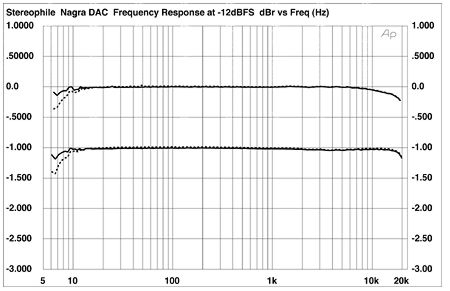
Fig.1 Nagra DAC, CD frequency response at -12dBFS into 100k ohms, with de-emphasis (bottom) and without (top). (Right channel dashed, 0.5dB/vertical div.)
The top two pairs of traces in fig.2 show 1/3-octave spectral analyses of the Nagra's balanced output while it decoded 16- and 24-bit data representing a dithered 1kHz tone at -90dBFS. The increase in bit depth drops the noise floor by around 17dB in the treble, implying almost 19-bit performance in this region. The improvement is less good at low frequencies, however. Even so, as shown by the bottom pair of traces in this graph, the Nagra can still resolve a dithered 24-bit tone at -120dBFS.
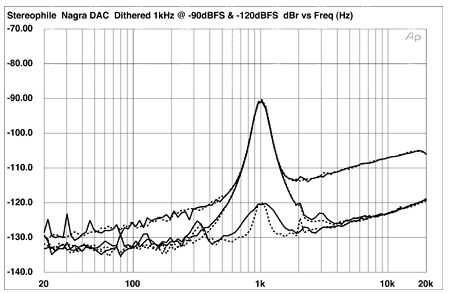
Fig.2 Nagra DAC, 1/3-octave spectrum of dithered 1kHz tone at -90dBFS, with noise and spuriae, 16-bit data (top) and 24-bit data (middle), with 24-bit dithered 1kHz tone at -120dBFS (bottom). (Right channel dashed.)
The linearity error on a dithered 16-bit 500Hz tone (fig.3) is superbly low down to almost -120dBFS, the increasing error below that level entirely due to the dither noise in the data. As a result of the nonexistent linearity error and the low noise, the waveshape of an undithered 1kHz tone at -90.31dBFS is perfect (fig.4), with the data's three DC voltage levels clearly defined. Increasing the word length to 24 bits gave a good sinewave shape, despite the absence of dither (fig.5).
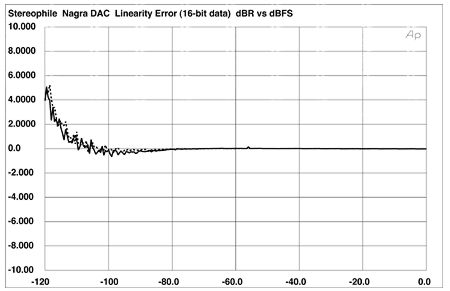
Fig.3 Nagra DAC, departure from linearity, 16-bit CD data (right channel dashed, 2dB/vertical div.).
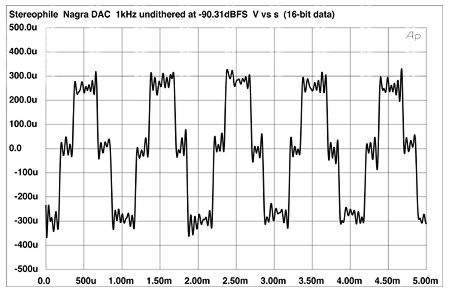
Fig.4 Nagra DAC, waveform of undithered 1kHz sinewave at -90.31dBFS, 16-bit data.
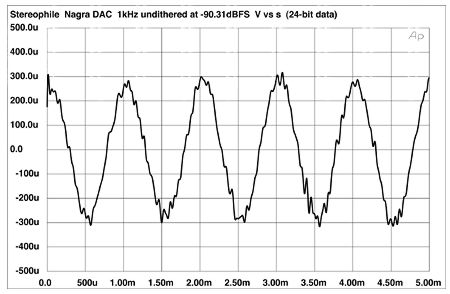
Fig.5 Nagra DAC, waveform of undithered 1kHz sinewave at -90.31dBFS, 24-bit data.
The Nagra offers vanishingly low distortion. Feeding it dithered 24-bit data representing a full-scale 1kHz sinewave gave the output spectrum shown in fig.6. The THD figures (actual sum of the harmonics) were just 0.0005% (left, black trace) and 0.0006% (right, red), with the second harmonic the highest in level at -108.5dB and -105.1dB (left and right, respectively). The left-channel figures are at the level of the test gear's residual. Dropping the load impedance to 600 ohms—something the Nagra will never see in real life—brought up the third harmonic to -80dB (0.01%), but this rise is academic. The Nagra's performance when fed an equal mix of high-level, high-frequency tones was similarly superb (fig.7). Note, by the way, that the noise floor in figs.6 and 7 is due not to the Nagra but to the 16-bit A/D converter in the National Instruments PC card (see my introductory comments).
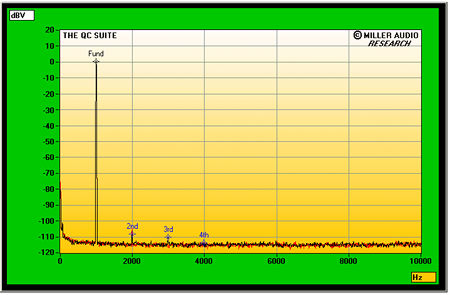
Fig.6 Nagra DAC, unbalanced output, spectrum of 1kHz sinewave, DC-1kHz, at 0dBFS into 8k ohms (linear frequency scale).
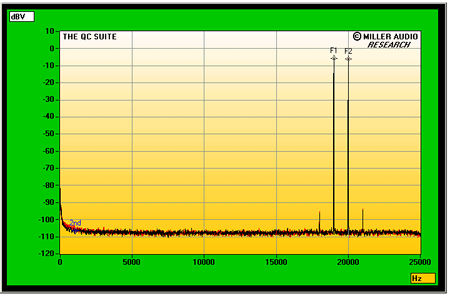
Fig.7 Nagra DAC, unbalanced HF intermodulation spectrum, DC-25kHz, 19+20kHz at 0dBFS into 8k ohms (linear frequency scale).
I used the Miller Audio Research Jitter Analyzer to test the Nagra's susceptibility to word-clock jitter, in conjunction with 16-bit data representing a high-level 11.025kHz tone over which had been overlaid a 229Hz squarewave at the LSB level. (Both tones are integer submultiples of the sample rate, meaning that anything else that appears in the analog output of the device under test will be due to problems of some kind.)
Driving the Nagra DAC with S/PDIF data from a PS Audio Lambda CD transport gave a measured jitter level of just 140 picoseconds peak-peak, which is superbly low. with almost all of that jitter data-related (red numeric markers). Changing the data source to my PC playing a WAV file and connected via a TosLink cable increased the jitter level to 333ps, with the increase due to low-frequency sidebands (not shown). While this is still very low in absolute terms, the difference between its electrical and optical performance suggests that the Nagra is not totally immune to data interface issues. Increasing the optical word length to 24 bits reduced the jitter to 163ps, with again the figure due to the LF sidebands (fig.8). Note also the slight widening of the central peak in this graph, which implies the presence of very-low-frequency random jitter. Peculiarly, the measured jitter changed with the setting of the Nagra's digital volume control.
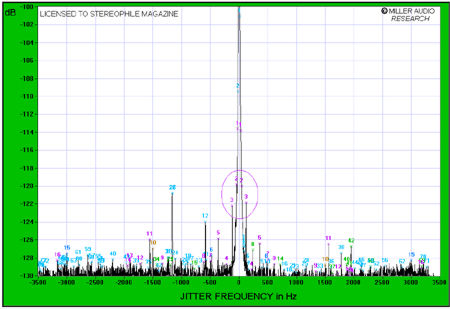
Fig.8 Nagra DAC, unbalanced output, high-resolution jitter spectrum of analog output signal (11.025kHz at -6dBFS, sampled at 44.1kHz with LSB toggled at 229Hz). Source: 24-bit WAV file sourced from a PC with an RME Digi96/8 Pro soundcard and a TosLink connection. Center frequency of trace, 11.025kHz; frequency range, ±3.5kHz.
As KR pointed out, the Nagra is unusual in that it digitizes its analog input, using a 24-bit A/D part running at 48kHz. Fig.9 shows the analog input's frequency response at 500mV input, equivalent to -12dBFS on the Nagra's modulometer with both balanced and unbalanced input signals. The top audio octave can be seen to roll off a little prematurely, reaching -1.5dB at 21.3kHz, above which the antialiasing filter kicks in big time.
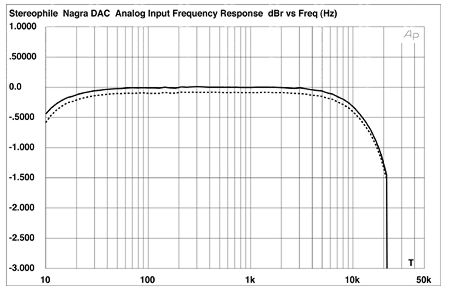
Fig.9 Nagra DAC, balanced analog input/output, frequency response at 1V into 100k ohms (right channel dashed, 0.5dB/vertical div.).
The A/D converter overloaded (1% THD) with a 2.03V sinewave. The modulometer showed 0dBFS/Overload with a 2V input. The analog input impedance (measured at 1kHz) was a usefully high 62k ohms unbalanced, 124k ohms balanced. Feeding the Nagra's analog input a 1kHz sinewave at 62;uV resulted in digital data at -90dBFS. Fig.10 shows a 1/3-octave spectral analysis of the Nagra's analog output under these conditions; at 4-5dB, the noise floor is only a little lower than that of the dithered CD data in fig.2, suggesting ADC resolution of around 17 bits.
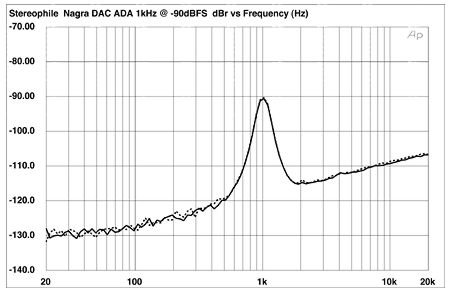
Fig.10 Nagra DAC, balanced analog input/output, 1/3-octave spectrum of 1kHz tone at -90dBFS, with noise and spuriae (right channel dashed).
At -6dBFS, the distortion level was a very low 0.0021%. However, this has increased to 0.01% at -1dBFS, with the spectrum (fig.11) having the third harmonic highest in level and some higher-order products becoming apparent. As with many A/D converters, the top couple of dB of dynamic range are best regarded as being for emergency use only. The Nagra's modulometer will be a big help in this regard.
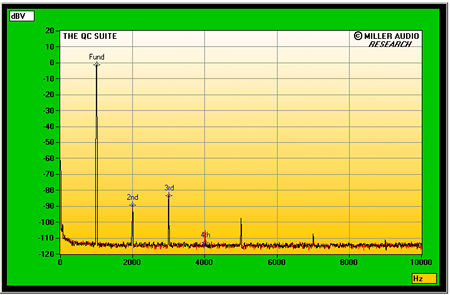
Fig.11 Nagra DAC, balanced analog input/unbalanced output, spectrum of 1kHz sinewave, DC-1kHz, at -1dBFS into 8k ohms (linear frequency scale).
While I share KR's feeling that a true analog pass-through input would be better than one that digitizes the signal, the Nagra DAC offers virtually state-of-the-art measured performance.—John Atkinson
- Log in or register to post comments




































